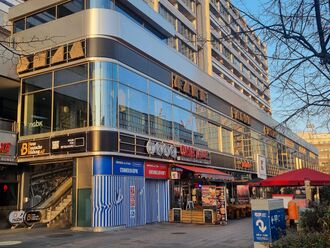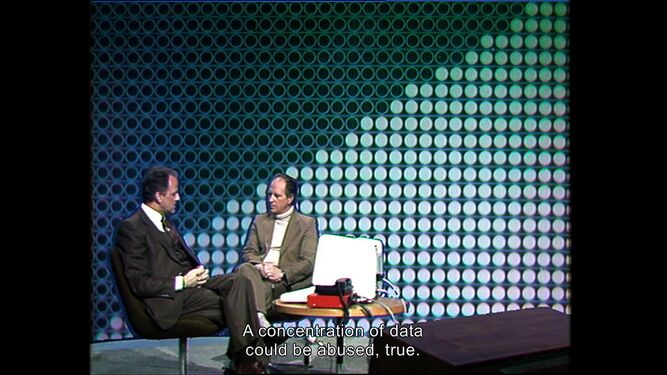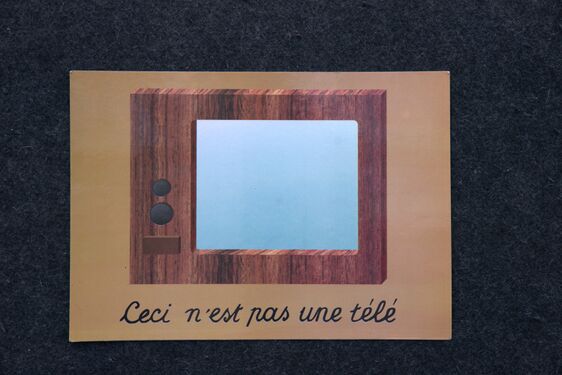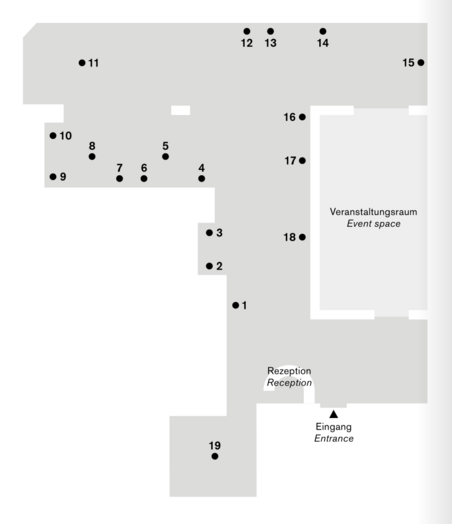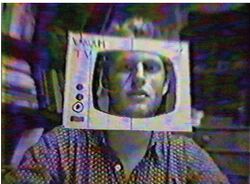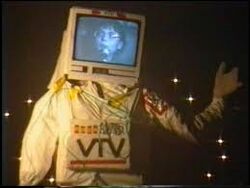EastUnBloc
- Reclaiming Experimental and Subversive Media art Practices from Central and Eastern Europe, 1958 to the Present
Group exhibition nGbK, Karl-Liebknecht-Str. 11/13, 10178 Berlin 29 November 2025 – 15 February 2026 Opening hours: Tue–Sun 12:00–18:00, Fri 12:00–20:00 Admission: free
Contents
- 1 Curatorial text
- 2 Works
- 3 Events
- 3.1 Opening
- 3.2 “Bring a Friend” – Early Night Show
- 3.3 Entropy Coding – Experiments with Video and Permacomputing
- 3.4 Net Art Gallery Surfing Session
- 3.5 Networks of Net Art – Syndicate and Deep Europe
- 3.6 Bye Bye My Eye: Confirmed. Understood. Over and out.
- 3.7 Archival Outreach Symposium
- 3.8 Finissage
- 4 Downloads
- 5 Links
35 years into the post-socialist transition in Europe, images of the “former East” are often still rendered in shades of gray. Only recently, Cold War scholarship is beginning to move away from a view of two monolithic opposing blocs, instead exploring the concept of alternate or parallel modernities rather than the idea of lack and lag in the former Eastern bloc. To add color to these images, explore the ruptures and permeability of the “Iron Curtain” and blast apart pre-conceptions, the group exhibition EastUnBloc presents subversive and experimental media art works and practices by more than two dozen artists and collectives from socialist and transition-era Central and Eastern Europe as well as the production contexts in which they were created. Beyond presentation, the exhibition seeks to reclaim these works, as “artistic intelligence”: inspiration and toolkits to respond to current challenges.
- With contributions by
- Aleksandra Domanović
- Andreas Broeckmann
- Art Servers Unlimited
- Benjamin Heidersberger
- Brendan Howell / permacomputing.net
- CUKT
- Dalibor Martinis
- Damir Radović
- Davide Grassi / Janez Janša
- D'epog
- Eclectic Tech Carnival
- Gusztáv Hámos
- Igor Štromajer
- Infermental
- Jennifer Helia DeFelice / Vašulka Kitchen Brno
- Krzysztof Wodiczko
- Laibach
- Lucia Repašská
- Marina Gržinić & Aina Šmid
- MetaForum
- Mike Hentz
- Monoskop
- Pneuma Szöv. / TV Free Europe
- Pneuma Vizuál
- Radúz Činčera / Alena Činčerová
- Sabine Vogel & Mike Steiner
- Sakrowski
- Sarah Alberti
- Satori
- Slovak Game Developers Association / Slovak Design Museum
- Szilárd Matusik
- Tereza Havlíková
- Tilman Baumgärtel
- Vákuum Tv: Dóra Csernatony, Kristóf Forgács, Dániel Garas, Donáta Gajzágó, László Kistamás, Attila Till
- Van Gogh TV / Piazza Virtuale
- Zbigniew Rybczyński
- Zemira Alajbegović & Neven Korda
- and others.
nGbK work group: Natalie Gravenor, Sarah Günther, Zsuzsa Berecz, Friedemann Bochow, Dušan Barok.
Funded by the Senate Department for Culture and Social Cohesion in Berlin. Supported by the German-Czech Fund for the Future.
Curatorial text[edit]
The five curators of the exhibition grew up in different countries along both sides of the former Iron Curtain. They experienced – firsthand or with the critical distance passed time allows – the social situation which shaped the exhibited works.
In Central and Eastern Europe, the late 1980s and early 1990s were marked by two intertwined paradigm shifts: the dissolution of state socialism and the dawn of the digital and internet age. This simultaneity brought about a diverse body of media works. EastUnBloc “reverse engineers” the underlying principles of these works and their production processes. Borrowing a term from computer programming, these principles and strategies are referred to as “scripts”.
They invite visitors to connect with the exhibited works and reflect their own past, future and present through the exhibits’ lenses.
Instead of insisting on a spatial, chronological or geographical dramaturgy, the scripts guide visitors to encounter works in an optional order, revealing themselves through color-coding and other clues in the exhibition design.
A cooperation with Wiki-based arts online library Monoskop provides background information throughout the exhibition.
Turn shit into chocolate[edit]
- using limited resources for maximal effect
Resources are generally scarcer for independent artists and activists, and that was certainly the case in socialist and transition-era Central and Eastern Europe. Combining available materials with ingenuity and imagination, the works applying this script are provocative, humorous and even trailblazing. They use lo-res formats like 16 mm, Super 8 or VHS, U-matic low band and Hi8 video, basic video signals, minimal computer code, such as the four kilobyte size digital animations of the Demoscene, ASCII characters, and GIFs. Found footage becomes raw material. Editing takes place in camera or with rudimentary cuts, or films are shot in one take. Props and sets are handmade; trash becomes costumes; minimalism becomes virtuosity. The “turn shit into chocolate” script echoes in for example the Dogme 95 manifesto’s creative restraints and permacomputing (see the accompanying program), a concept and community of practice oriented around issues of resilience and regenerativity in computer and network technology inspired by permaculture.
Reality bending[edit]
- hacking the system with pranks and hoaxes
Analogous to the musical practice of circuit-bending – creative manipulation of circuits in electronic devices to get an output that was not intended by the manufacturer – the exhibition uses the term “reality bending” to highlight works that hijack power structures. Through parody, overaffirmation, or unexpected disruption, these works reveal hidden truths, empower the powerless (if only for a brief moment), and show that a different situation is possible.
While reality bending is a practice adopted for progressive and emancipatory aims, some works also deal with ethical questions and possible unintended adverse effects.
Media artists and activists in Central and Eastern Europe frequently used reality bending as an underlying “script.” Some works ruptured rigid and oppressive state media, in particular television, through illegal and high-risk actions or, as in the Slovenian art group Laibach, by parody or détournage of official symbols and messages. Others, like Krzysztof Wodiczko with his Lenin Monument, used media as interventions in public space.
Make your own media[edit]
- self-empowerment through media production
Bertolt Brecht famously said in the early 1930s, with the advent of radio as a mass medium, that radio not only allows one sender to reach a broad audience in a top down fashion, its technology also has the potential for each receiver to broadcast their own programming.
Then 16 mm and Super 8 film emerged which could be developed at home – crucial particularly in Central and Eastern Europe to avoid state control through film labs. Later video formats such as VHS, Video / Hi8 and (Mini)DV became accessible, empowering more people to create their own media. Non-conformist self-expression, aesthetic exploration, and sharing suppressed information were some of the aims of this practice.
In the strongly controlled media system of the socialist era, alternative niches emerged. In state supported or tolerated experimental film and video art practices in Poland, Hungary, Yugoslavia, and Romania, abstract visual art works flew under the radar of censors who were watching out for explicit, often verbal artistic expression. Amateur films, which occasionally tested limits of form and content, were produced in clubs associated with worker leisure time and worker creativity encouragement or, as in Yugoslavia, as part of aesthetic education.
Autonomous production occurred with Super 8 film cameras and video equipment, sometimes smuggled from the West.
This allowed the creation of a wide range of “audiovisual samizdat,” underground self-publishing practices ranging from experimental works which challenged aesthetic norms to documentations of suppressed political movements such as Charta 77 in Czechoslovakia and Solidarność in Poland.
This script also encompasses interactivity. While the audience is not completely autonomous, it is a co-creator or at least has a decision-making option within the works, foreshadowing today’s media landscape of individual prosumers. The exhibition presents Kinoautomat, the first large-scale interactive narrative film from Czechoslovakia which premiered at Expo Montreal in 1967, and DemoKino, a 21st century response exploring interactivity and political decision-making.
Furthermore, net art works follow this script, using the interactive features of the internet browser and hypertext, as well as 1980s independent computer games from Czechoslovakia, some of which had explicit political themes.
Bring a friend[edit]
- creating communities by throwing a political party
As authorities in Central and Eastern Europe often sowed suspicion to better control their subjects, friendship became particularly precious. It also was a means of resistance. Long nights in pubs engendered not only hangovers but also plans for artistic and political activity. Private social gatherings became informal art exhibitions, fashion shows, concerts, poetry readings, film screenings, and happenings. Circles of friends co-created and had each other’s backs, worked and lived together. Making art became a way of life. And despite mistrust of potential secret police informers, encounters with the unfamiliar – people with different backgrounds and life situations as well as new experiences – were welcome.
Works using this script document avant-garde fashion which irreverently used socialist symbols. Intermedia club culture, where music, media art, design, dancing and performance merged, became labs for social change or a safe space for expressing queer identities.
Expose the seams[edit]
- revealing media’s underlying processes
The persuasive effect of media often relies upon the audience’s ignorance of how it works. Official media in socialist countries also strived to remain untransparent. Particularly in the postmodern era, questioning the power of media by exposing its inner workings became a key issue for scholars and artists on both sides of the Iron Curtain.
Works using this script are highly experimental and self-referential, deviating the most from conventional viewing habits. The presence of the camera is highlighted by breaking the fourth wall or showing the recording apparatus. Editing, usually invisible in classical narrative cinema, is foregrounded. Some structuralist works explore the materiality of film and video: film grain, electromagnetic signals, video dropouts, pixels, and other digital glitches. Some works walk viewers through the process of creation.
Space in time[edit]
- forging connections across spatial and temporal boundaries
Geography and history, intertwined manifestations of space and time, particularly shaped everyday life and states of mind in Central and Eastern Europe. Centuries of armed conflicts, domination by foreign colonial powers, and the redrawing of national borders impacted identities. The establishment of the capitalist and socialist blocs in post-war Europe resulted in the Iron Curtain as a seemingly invincible barrier with a far-reaching shadow.
As a consequence, much artistic practice engaged with ghosts of the past and utopian or dystopian futures as they blur or battle each other in the present.
The projects in the exhibition, through networks of likeminded artists all over Europe, forged connections via the distribution of analogue videotapes through semi-official channels like Infermental. Others used TV broadcast and early internet technologies, as did Van Gogh TV with Piazza Virtuale, or created a dialogue between past and future selves. And Transcentrala by Marina Gržinić & Aina Šmid explores how artist collective NSK (Neue Slowenische Kunst) developed a theory of history and concept of a postnational world transcending borders. In 1992, the collective founded NSK State in Time, which inspired this script’s name.
Works[edit]
2
Marina Gržinić & Aina Šmid
Transcentrala
(Neue Slowenische Kunst State in Time)
SI 1993
Video, Beta SP, 20 min
Color, sound
Production: TV Slovenia / Artistic Programme
Slovenian with English subtitles
The Blind Spot
Installation by Damir Radović
for the exhibition
Spaceship Yugoslavia, nGbK 2011
Photo: Nihad Nino Pušija
3
Dalibor Martinis
DM 1978 Talks to DM 2010
YU (HR) 1978/2010
Video, 13 min
Color and b/w, sound
Croatian with English subtitles
DM 2024 Talks to DM 1978 – HRT
HR 2024
Video, 19 min
Color and b/w, sound
English
4
Infermental
1980–1991
International video art magazine with contributions by various artists
Documents, posters, graphics
Source: ZKM Collection
© ZKM – Center for Art and Media Karlsruhe, 1980–91
Infermental Berlin, Mediascreen Display Ku’damm Eck
Source: ZKM Collection
Photo: Zoltán Jancsó, 1982; © Vera Baksa-Soós
5
Aleksandra Domanović
Grobari
2009
Inkjet prints on A4 paper, 3,500 pages
From yu to me
2013/14
HD video, 35 min
Color, sound
6
Igor Štromajer
101.72 MB
SI 1996–2007, 2024
Seven framed electric machines, one robot
7
Art Servers Unlimited
GB 1998
Video, 30 min
Color, sound
English
/ETC Eclectic Tech Carnival 2011 Belgrad
GR/SR 2011
By: βιντεοκολλεκτίβα Κινηματόγραφος & GenderChangers
Video, 6 min
Color, sound
English
MetaForum 1–3 (1994–1996) Revisited
HU 2024
By: Flóra Barkóczi & students of the Intermedia Department at the Hungarian University of Fine Arts
Video, 11 min
Color, sound
English
8
Slovak Computer Games
1987–1994
Playable English localizations of Slovak digital games for Fuse emulator
Translation project created by Slovak Game Developers Association in cooperation with Slovak Design Museum
Translation: Stanislav Hrda, Slavomír Labský, Marián Kabát, Darren Chastney, Jakub Celušák,
Maroš Brojo
Sinclair ZX Spectrum Computer
Exhibit (not functional)
Loaned by: Computerspielemuseum Berlin
9
Monoskop
Shadow libraries
2015/2025
Digital print (website), 41 x 570 cm
10
Satori
Different Engine
SK/FI 2000
By: Zden Hlinka / Satori (code, graphics) & Esa Ruoho (music)
Video (PC demo), 2 min
Black/white, sound
Metamorf
SK/PL 2000
By: Zden Hlinka / Satori (code, graphics) & Raiden / Aural Planet (music)
Video (PC demo), 3 min
Color, sound
B10
SK 2001
By: Zden Hlinka / Satori (code, graphics) & David Bennar (music)
Video (PC demo), 4 min
Color, sound
Szilárd Matusik
Stamps Back – A Moleman Story (excerpts)
HU 2022
Documentary about the origins of the Hungarian demoscene and home computer subculture
Video, 10 min
Color, sound
11
Pneuma Szöv. / Pneuma Vizuál
Studio TV Free Europe
2025
Spacetime travel device with props
TV Free Europe
Budapest, Szombathely, Leipzig, Tårnby Torv/Kopenhagen, Nova Gorica, Oberwart, Online
2019–2021
Artistic coordination: Pneuma Szöv.
With various video works from Studio Budapest
TV Free Europe Program Announcements Mon–Sun
Budapest 2020/21
Online channel by Szilveszter Jenei
7 x ca. 1 min
English
Working Party – The Telepathy Machine #1
Online live show during the COVID-19 pandemic by Pneuma Szöv. + Pneuma Vizuál, Budapest, 1.5.2021
115 min
English
With: Róbert Békefi, Zsuzsa Berecz, Csilla File, Sarah de Günther, Csilla Hódi, Szilveszter Jenei, Bernadett Jobbágy, David Karla, Boglárka Lutz, Zoltán Lehoczky, Lilla Magyari, Viktor Markos, Gergely Pápai, Dorottya Poór, Júlia Salamon, Luca Szabados, Dániel Szapu
Teletext about TV Free Europe
Budapest, 2020
3 min
Text: Klára Nagy, szinhaz.net
Teletext video: de Günther / Pneuma Szöv.
12
Krzysztof Wodiczko
Lenin Monument. Leninplatz, Berlin, 1990
D/PL 1990
Commissioned work for the exhibition
The Finiteness of Freedom, Berlin, 1990
Large format photo by: Werner Zellien
Loaned by: Profile Fundacja
Sabine B. Vogel & Mike Steiner
Every Monument Is A Person
D 1990
Video, 23 min
Color, sound
German, English
Courtesy of: Raik Müller
13
Lenin Projection Workshop
2025
3D print (model: Bormuh), Polylux
14
C.U.K.T. (Piotr Wyrzykowski)
Wiktoria Cukt 2.0 Rebirth
PL 2025
Video installation
Wall Print Collage
2025
Composite visual documentation: fragments of original Wiktoria Cukt campaign poster (2000) and Wiktoria Cukt 2.0 Wiktoriomat poster (2025)
Digital print, 300 x 200 cm
Presidential Campaign of Wiktoria Cukt
2001
Video documentary by Piotr Wyrzykowski
Documentation of C.U.K.T. (Central Office of
Technical Culture) campaign intervention, 2000
Officials: Rafał Ewertowski, Mikołaj Jurkowski, Artur Kozdrowski, Jacek Niegoda, Maciej Sienkiewicz, Piotr Wyrzykowski
Video, 27 min
Color, sound
Extended Interview with Wiktoria Cukt 2.0: Years 2024–2025
2025
Video documentary by Piotr Wyrzykowski
Documentation of Wiktoria Cukt 2.0 rebirth by C.U.K.T.
Officials: Mikołaj Robert Jurkowski, Piotr Wyrzykowski
Video, 49 min
Color, sound
Official Campaign Poster
2000
Wiktoria Cukt presidential campaign poster
C.U.K.T. (Central Office of Technical Culture)
Digital print, framed, 40 x 50 cm
Official Presidential Poster
2025
Wiktoria Cukt 2.0 Wiktoriomat poster
C.U.K.T. (Central Office of Technical Culture)
Official: Piotr Wyrzykowski
Digital print, framed, 40 x 50 cm
Official Exposé of Wiktoria Cukt
2000
C.U.K.T. (Central Office of Technical Culture)
Digital print, framed, 21 x 29,7 cm
Aarhus Declaration
2025
Wiktoria Cukt 2.0 & C.U.K.T.
Official: Piotr Wyrzykowski
Digital print, framed, 21 x 29,7 cm
15
Vákuum TV
Monoszkóp
1995
Hand-painted opening title screen for the broadcasts of Vákuum TV
Acrylic, canvas
268 x 216 cm
Vákuum TV
Vákuum TV
1994
Stage set built for the shows of Vákuum TV in the Budapest nightclub Tilos az Á
Wood, tulle
264,5 x 369 cm
Vákuum TV introduction
HU 2025
Produced by Vákuum TV for EastUnBloc, using original video footage
of the Vákuum TV archive
Video, 4:28 min
Vákuum TV
HU 1995
Compilation from the Vákuum TV archive about the group. Pre-graduation work of Vákuum TV member Kristóf Forgács, produced at Medienzentrum of UdK Berlin
Video, 46:04 min
Hungarian, dubbed into German
Performers: Members of Vákuum TV
Other performers:
Studio speaker: Rolf Gänger
Art policists: Martin Willis, Marc Stephan
Christo Vladimirov Javacheff: Tilman Wendland
Camera: Iván Artner, János Szirtes, Virág Csejdy, Martin Willis
Voice actors: Marc Stephan, Silke Gänger
Translation: Bak Gara
Vákuum TV at Next 5 Minutes
HU/NL 1996
Excerpts from the video documentation of Vákuum TV's performance at the Next 5 Minutes 2 International Festival of Tactical Media,
Amsterdam, 18.–21.1.1996
Produced by Tactical Media Files
Online video, 10:17 min
16
Van Gogh TV
Piazza Virtuale
1992
Piazza virtuale – The Documentation
D 1993
By: Utta C. Hoffmann & Van Gogh TV
Video, 33 min
Color, sound
English
Piazza virtuale – Dokumentation
D 2021
By: Tilman Baumgärtel & Julian Weinert
Produced by: Institut für Mediengestaltung
Video, 40 min
Color, sound
German with English subtitles
Configuration Piazza Virtuale
1992
Benjamin Heidersberger / Van Gogh TV
Wall plan, Billboard-Print, 2 x 3 m
Logo Van Gogh TV
Inkjet print on A3 paper
Broadcast Studio Kassel
Ole Lütjens, Salvatore Vanasco, Katrin Brinkmann
Black and white photography
Photo: Ali Altschaffel
Screenshots of some Piazzetta (Broadcast Studios)
by Van Gogh TV and various artists and collectives
8 inkjet prints, 58 x 43 cm
Photo printouts produced for the exhibition Van Gogh TV: Piazza virtuale, Künstlerhaus Bethanien, Berlin 2021
Piazzetta Praha
Organizers: First Piazzetta Prague: Michael Bielický (Akademie der Bildenden Künste), Second Piazzetta Prague: Ika Kröger
Participants: Tomáš Mašín, David Saudek, David Christoff, Keiko Sei, Prof. Milan Knížák, Richard Gaynor and others
Piazzetta Riga
Participants: Baiba Ripa, Valdis Martinsons, Liena & Edgars Muceniers, Ojārs Pētersons, Aigars Sparāns, Hardijs Lediņš, Artis Dzērve, Kristina Dregene and others
Piazzetta Bremen
Organizers: students of Bremer Hochschule für Künste
Initiators: Axel Roselius & Ronald Gonko, Jörg H. Wolff, Prof. Gerd Dahlmann
Participants: Stefan Doepner, André Szigethy, Ole Wulfers, Tobias Küch, Rachid Ali Khan, Beate Skiba, Hank Normann, Katrin Orth, Veronika My, Daniela Aligeri, Martina Schall, Joschi Jung and others
Piazzetta Hamburg
Organizers: Frauen und Technik (Ellen Nonnenmacher, Bettina Schoeller, Lore Piatkowski, Ania Corcilius, Cornelia Sollfrank, Korinna Knoll, Annette Kisling, Silke Mauritius, Janine Sack, Christine Bader)
Piazzetta Paris
Organizers: Christian Vanderborght
Participants: Christian Vanderborght, Frank Barte, Jacques Bigot, Karim Baupin, Arnaud Mayet, David Dronet, Stefano Zanini, Eric Madeleine and others
Piazzetta Ljubljana
Organizers and participants:
Production unit in Ljubljana: Radio Student, KUD France Preseren, Kanal A
Produced by: Marko Košnik / Egon March Institute
Performers: Ema Kugler, Mojca Dimec, Mojca Kumerdej, Lidija Bernik, Franc Purg, Sebastjan Starič, Bojan Štokelj, Mare Kovačič, Silvo Zupančič, Marko Košnik
Contact studio: Snežana Levstik, Jure Longyka
Local transmission: Peter Levart, Miran Divjak, Miran Kajin, Borut Savski
Intellectuals: Jelena Lovrić, Silva Mežnarić, Rade Šerbedžija, Slavoj Žižek, Damjan Bojadžiev, Gorazd Suhadolnik, Radko Polič, Goran Janković, Haris Burina, Rastko Močnik, Petar Luković
Piazzetta Nagoya
Organizers: Nippon Hōsō Kyōkai (NHK – Japan Broadcasting Corporation)
Participants: Eiichi Kubota (program director NHK), Atsushi Ogata (translator in Kassel)
Piazzetta Genève
Philippe Coeytaux, Alessandra Mueller and others
17
Davide Grassi
DemoKino – Virtual Biopolitical Agora
SI 2005
Interactive DVD
Color, sound
English, Slovenian, Italian versions
18
Radúz Činčera / Alena Činčerová
Kinoautomat
ČSSR/CZ 1967/2009
DVD version of the first interactive movie
Color and b/w, sound
Czech-English version
19
TV Tower Lounge
TV program installation, films and videos 1958–2010
For details see the program guide
Loaned by: Collection Video-Forum,
Neuer Berliner Kunstverein (n.b.k.), Filmoteka Muzeum Sztuki Nowoczesnej w Warszawie and the works’ authors
Events[edit]
Opening[edit]
- nGbK. Fri, 28 Nov 25, 18:00 h
With an intervention by the art network Pneuma Szöv. (Budapest/Berlin) and special guest Kristóf Forgács (Vákuum TV).
“Bring a Friend” – Early Night Show[edit]
- nGbK. Sat, 29 Nov 25, 19:00–20:30 h
TV Free Europe presents:
A performance and time travel talk show by Pneuma Szöv. (Budapest/Berlin) and guests: Gusztáv Hámos, Mike Hentz and Benjamin Heidersberger. – Live at and from nGbK!
Entropy Coding – Experiments with Video and Permacomputing[edit]
- nGbK. Tue, 2 Dec 25, 14:00–18:00 h
Workshop with Brendan Howell (artist and reluctant engineer, wintermute.org, permacomputing.net):
Experimenting with outmoded and low-fi digital cameras as tools for new aesthetics and narratives.
Net Art Gallery Surfing Session[edit]
- nGbK. Sun, 11 Dec 25, 19:00 h
with Sakrowski (curator, netzkunst.berlin) and Igor Štromajer (artist)
More about the event on the panke.gallery website.
Networks of Net Art – Syndicate and Deep Europe[edit]
- nGbK. Tue, 13 Jan 26, 19:00 h
with Tereza Havlíková (curator, netzkunst.berlin) and Andreas Broeckmann (curator and researcher)
Bye Bye My Eye: Confirmed. Understood. Over and out.[edit]
- nGbK. Wed, 28 Jan 26, 19:00 h
Live cinema. Live performance. Half dead reality of those who sailed into the known. © D'epog.
Archival Outreach Symposium[edit]
- nGbK. Thu, 29 Jan 26, time tbc
with Jennifer Helia DeFelice (Vašulka Kitchen Brno), Lucia Repašská (D'epog), and others.
Finissage[edit]
- nGbK. Sun, 14 Feb 26, 18:00 h

